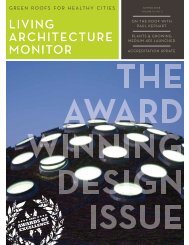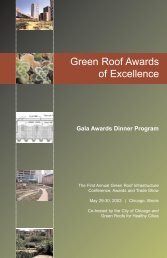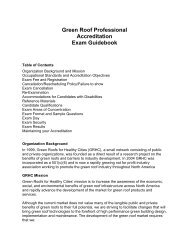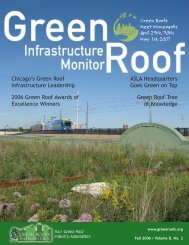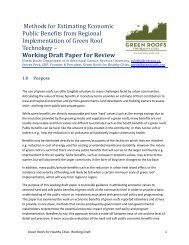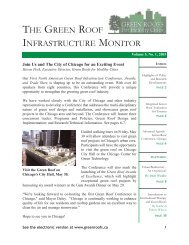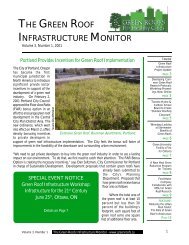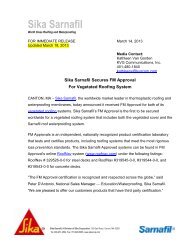Living Architecture Monitor - Green Roofs for Healthy Cities
Living Architecture Monitor - Green Roofs for Healthy Cities
Living Architecture Monitor - Green Roofs for Healthy Cities
Create successful ePaper yourself
Turn your PDF publications into a flip-book with our unique Google optimized e-Paper software.
“The design process is<br />
organized into seven<br />
explicit steps, which aid<br />
in matching appropriate<br />
wildlife species to a functional<br />
green roof system.”<br />
In this case, Elbowbush (Forestiera pubescens), a shallow rooted Plains<br />
bush provided structure while Sand Dropseed (Sporobolus cryptandrus)<br />
and Idaho Fescue (Festuca idahoensis) served as grassy height and <strong>for</strong>age.<br />
Shale adapted Blue Grama (Bouteloua gracilis) holds soil and native<br />
<strong>for</strong>bs like Evening Primrose (Oenothera speciosa) and Beebalm<br />
(Monarda fistulosa) sustain insect populations. Finally, edging the building<br />
with trees supplements woody height and eases transition to the roof.<br />
The project in<strong>for</strong>mation is currently being used to educate local officials<br />
and designers on the use of a template approach to green roof<br />
habitat. It is our hope this step-by-step model will assist you in creating<br />
restorative habitats on green roofs and walls. <br />
THESEVENDESIGNSTEPS<br />
FROMIDENTIFICATIONTOFINALHABITAT<br />
STEP<br />
identify a threatened bird species in need of nesting habitat<br />
STEP<br />
locate under-utilized, low slope roof<br />
STEP<br />
confirm that your roof is adjacent to open land<br />
STEP<br />
be creative with locally available materials <strong>for</strong> the growing<br />
substrate<br />
STEP<br />
calculate the substrate’s weight and the structure you’ll need to<br />
support it<br />
STEP<br />
design your base substrate<br />
STEP<br />
design the nesting habitat, focusing on indigenous plants and<br />
biodiversity<br />
RECOMMENDEDREADINGS<br />
Brenneisen, S. (2003). Biodiversity of European <strong>Green</strong>roofs. In conference<br />
proceedings of <strong>Green</strong>ing Rooftops <strong>for</strong> Sustainable Communities<br />
Chicago, Illinois. <strong>Green</strong> <strong>Roofs</strong> <strong>for</strong> <strong>Healthy</strong> <strong>Cities</strong>.<br />
Coffman, R. (2007). Comparing Wildlife Habitat and Biodiversity<br />
Across <strong>Green</strong> Roof Type. In the conference proceedings of <strong>Green</strong>ing<br />
Rooftops <strong>for</strong> Sustainable Conference, Minneapolis, Minnesota,<br />
<strong>Green</strong> <strong>Roofs</strong> <strong>for</strong> <strong>Healthy</strong> <strong>Cities</strong>.<br />
Lundholm, J. (2006). <strong>Green</strong> <strong>Roofs</strong> and Facades: A Habitat Template<br />
Approach. Urban Habitats Dec. Vol 4, Issue 1, pages 87 — 101.<br />
Rozenweig, M. L. (2003) Win-Win Ecology: How the Earth’s Species Can<br />
Survive in the Midst of Human Enterprise. Ox<strong>for</strong>d University Press.<br />
Dr. Reid Coffman, Ph.D. is an assistant professor of landscape architecture<br />
at the University of Oklahoma. He is a founding member of the International<br />
Research Committee <strong>for</strong> <strong>Green</strong> <strong>Roofs</strong> <strong>for</strong> <strong>Healthy</strong> <strong>Cities</strong> and<br />
a past fellow with the National Wildlife Federation. He holds degrees in<br />
urban ecology, environmental horticulture and landscape architecture.<br />
Allison Thurmond is a fifth year architecture student at the<br />
University of Oklahoma based in Norman, Oklahoma, with a focus<br />
on Environmental Studies and Anthropology. She is also a LEED®<br />
accredited professional and a National Merit Scholar.<br />
PLANTRATIONALEKEY<br />
USETHISGUIDETODETERMINEPLANSUITABILITY<br />
F/FORAGE<br />
produce seeds eaten by the Dickcissel<br />
N/NESTING<br />
locate under-utilized, low slope roof<br />
C/COVER<br />
provides height and protection <strong>for</strong> the Dickcissel and its insects<br />
I/INSECTATTRACTOR<br />
sustains invertabrate communities needed as a <strong>for</strong> source <strong>for</strong><br />
nesting Dickcissel pairs<br />
W/EVERGREEN<br />
maintains evapotranspiration and insulating plant material year<br />
round, improving the per<strong>for</strong>mance of the roof<br />
E/EROSIONCONTROL<br />
helps hold substrate in place, a concern with the additional wind<br />
and runoff erosion stresses on an elevated habitat<br />
S/SOILFIXER<br />
maintains or replaces nitrogen and organic matter in the soil, critical<br />
<strong>for</strong> long-term success <strong>for</strong> the roof




